Bhanu Athaiya's life story is a testament to the power of talent, determination, and passion. Born in Kolhapur, India, in 1929, Bhanu's artistic journey was shaped by her father Annasaheb Rajopadhye, an amateur artist who introduced her to the world of art. Kolhapur, a significant artistic center in the early 20th century, was a hotbed of creativity and social upheaval, with the local king actively promoting artisans. This environment exposed Bhanu to the likes of Abalal Rahiman, Dhurandhar, and Baburao Painter, who were prominent figures in the artistic circle of Kolhapur. Of particular note, Baburao Painter was a multifaceted artist who made significant contributions to both painting and filmmaking in India.
Tragedy struck when Bhanu lost her father at the tender age of nine. Despite this early setback, the initial encouragement and the artistic environment she had grown up in continued to fuel her passion for art.
Her journey into the world of art took a significant turn when she won a prize for her art in high school. It was during this time that she was introduced to Dancer and Theatre Director Hima Devi, whose friendship and collaboration would extend throughout Bhanu's career and life. Later she created theatre costumes for Hima Devi's productions, including classics like Taming of the Shrew, Hamlet, and The Importance of Being Earnest.
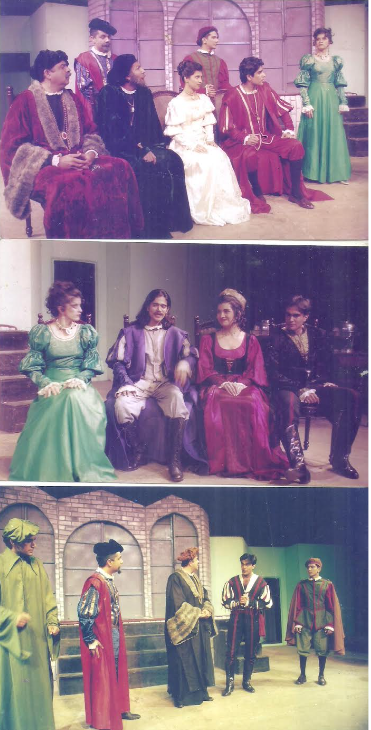
Taming of the Shrew
Recognising her talent, Bhanu's high school art teacher recommended her to attend the prestigious JJ School of Art in Bombay. During her time at JJ School, she found temporary lodging at a convent in Mazgaon, Mumbai, which provided her with a quiet and conducive environment for her artistic pursuits. The stained glass colours and the atmosphere around the temples in Kolhapur left a profound impact on her art.

Her dedication and talent culminated in her receiving the prestigious Usha Deshmukh Gold Medal at JJ School for her final year submission, Lady In Repose. This was a hallmark achievement and a testament to her exceptional talent and dedication to her craft.
In 1951, Bhanu Athaiya received an invitation that would change the trajectory of her career. She joined the Progressive Artists' Group, a collective of avant-garde artists that included luminaries like VS Gaitonde and Tyeb Mehta. Remarkably, she was the only woman artist in this groundbreaking group.
Recepient of the French government ASTEF scholarship in the early 60's for studies in Paris.
While her fine art career showed immense promise, Bhanu Athaiya made a significant transition into costume design. Encouraged by stars like Nargis and Kamini Kaushal, she ventured into the world of Bollywood films, with CID in 1956 marking her debut as a costume designer.
The pinnacle of Bhanu Athaiya's career arrived in 1983 when she became the first Indian to win an Oscar for costume design, awarded for her work in the film Gandhi. This historic achievement solidified her position as an icon in the world of costume design.

Mumtaz in Brahmachari
Throughout her illustrious career, Bhanu Athaiya was known for setting fashion trends through her costumes. From Sadhna's iconic tight-fitting kurta churidar to the legendary Satyam Shivan Sundaram costume and Mumtaz's iconic orange saree (which was an upscale of a Santhal Tribal woman's saree), her designs left an indelible mark on Indian cinema.
Bhanu Athaiya's talent extended to designing for a plethora of Bollywood stars, including Simi Grewal, Rekha, Hema Malini, Zeenat Aman, Nadira, Meena Kumari, and Waheeda Rehman, among many others. She also created designs for male actors like Dharmendra, Shah Rukh Khan, Aamir Khan, and numerous others, contributing to the success of many superhit movies.
Apart from her work in the film industry, Bhanu Athaiya held her own fashion shows early in her career. Notably, she was the designer of the first Calico Fashion Show in 1958, and she received an invitation from Ebrahim Alkazi, a prominent theater producer.
Images from the Fashion Show at Calico in the 1960s showcasing her contributions to the world of fashion and textiles, highlighting her impact on this industry as well.

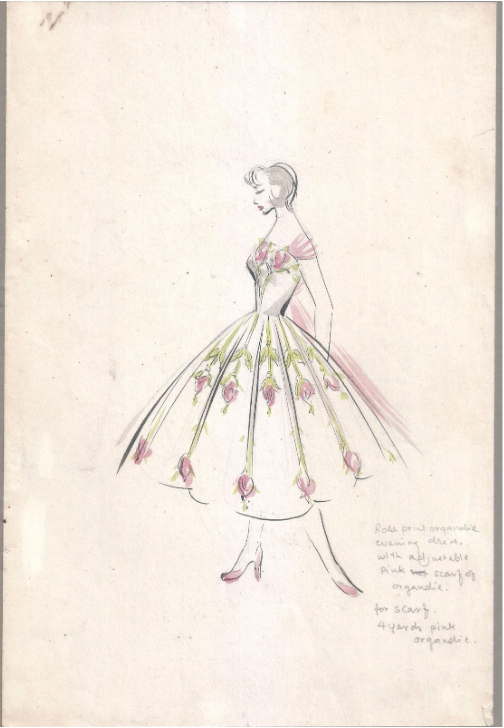
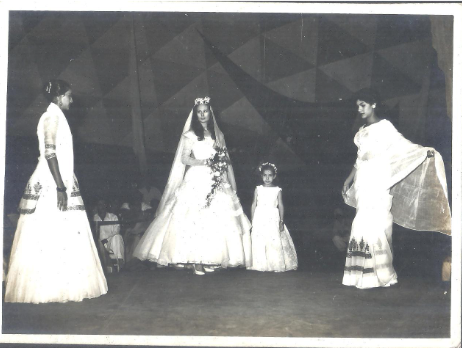

In a recent insightful interview featuring Ashutosh Gowariker and Sonam Kapoor, both renowned figures in the world of Indian cinema, a remarkable observation was made by Ashutosh. He noted that over the span of five decades, an astounding 70% of the iconic costumes that graced the heroines of Indian cinema were meticulously crafted by none other than the legendary Bhanu Athaiya. This statistic not only underscores her enduring influence but also highlights her immense contribution to the cinematic world.
Bhanu Athaiya's artistic brilliance extended beyond the silver screen and into her sketchbooks. Her sketches were a testament to her versatility, ranging from the glamorous world of cabaret to the simplicity of a village girl, from the opulence of period movies to the relatability of the girl next door. These sketches, a treasure trove of creativity, provide a glimpse into her artistic range and the diverse characters she breathed life into through her costume designs.
Notably, three of these sketches originated from her work on the iconic films Amrapali and Razia Sultan, showcasing her ability to transport audiences through time and space with her costume creations. Bhanu Athaiya's sketches serve as a visual testament to her extraordinary talent, immortalizing the characters and eras she brought to life on screen.
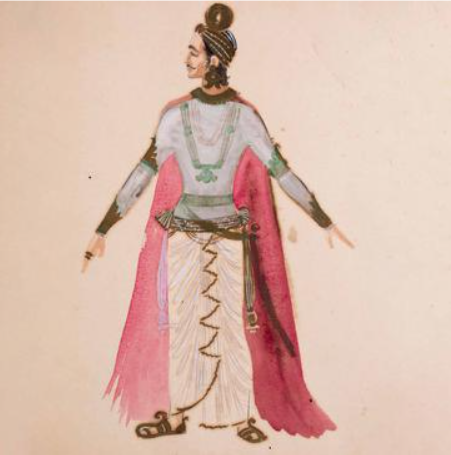
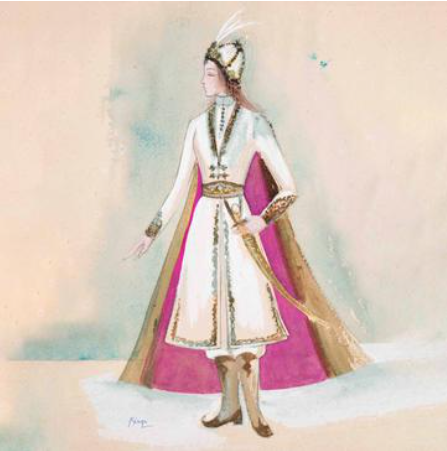

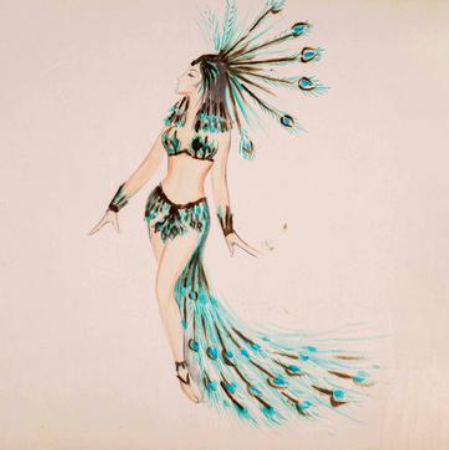
Bhanu's artistic background was a unique aspect of her costume designs. The detailed artist sketches of her costume designs were works of art in themselves, offering insights into her creative process and her dedication to her craft. These sketches were not just conceptual or research sketches; they were miniature works of art.
Many of Bhanu Athaiya's artworks from her fine art period and costume sketches are institutionally held, with some being preserved at the Kiran Nadar Museum of Art.
To gain further insights into her career and contributions, you can watch a video discussion between Kiran Nadar, the chairperson of the Kiran Nadar Museum of Art, and Ritu Kumar, the founder of one of India's largest and most renowned fashion houses.
Annexures
Annexures include a letter from Krishen Khanna, the last surviving member of the Progressive Artists' Group, acknowledging her contribution, and a heartfelt tribute from Alaknanda Samarth, A RADA (Royal Academy of Dramatic Art) Graduate and a trailblazer in portraying complex, contemporary women on stage.Letter from Krishen Khanna
 Letter from Alaknanda Samarth
Letter from Alaknanda Samarth
Bhanu was my friend. I first met her in 1987. I was told she would be doing the costumes for my solo double bill, 'KUNTI and THE HUMAN VOICE' by G. Sankara Pillai and Jean Cocteau in Bombay. Kumar Shahani, the director, introduced us. Bhanu would glide in and sit discreetly in a far corner of the rehearsal room, sketchpad in hand, head lowered, as I rehearsed 8 hours a day.
Four hours in the morning on 'KUNTI' in Hindi - from the Mahabharata. 4 hours after lunch on 'THE HUMAN VOICE' in English, a Parisian woman desperately in love. The complicated choreography was by Chandralekha, the producer was Veenapani Chawla, and the set was by Akbar Padamsee. I never saw the sketches. But I wore the exquisitely appropriate 2 costumes, with the fluidity, freedom, shape, and emotional texture they gave the 2 characters from two different cultural worlds I was performing. Bhanu's understanding of fabric and lighting gave them a contrasting luminosity, a lightness. She also dressed the set (I still have the delicate, oyster-coloured, crocheted bedspread she used in 'THE HUMAN VOICE'). 'India Today' described the show as a landmark in Indian Theatre'. During the performances, Bhanu was always on hand. We did shows in Delhi which I literally wouldn't have gotten through without her.
She did my costumes for 3 films, 'Khayal Gatha', 'Kasba', and 'A Memoir of the Future', all directed by Kumar Shahani. 'A Memoir of the Future' was an Indo-British coproduction with Nigel Hawthorne, Peter Firth, Carol Drinkwater, Angela Pleasance, Nick Clay, Neil Cunningham Jalal Agha, Tom Alter, and me. It was about Wilfrid Bion, the renowned psychoanalyst, and his early years in India. I appear in several avatars, such as the River Jumna, a Maharani, the Ayah, and more. Such complex period costumes in various palettes on a shoestring budget. The filming was in India.
In dire circumstances. The film remains unfinished. The funds ran out. Bhanu was like a rock. The research, imagination, and daring in her work were a huge protection for the international actors. Looking at the edited rushes today, you marvel at her costumes and with such stringent means. She delivered the goods, as always. Whatever was going on around her, Bhanu remained composed and observant.
We were good friends. One of the first stops when I landed in India was her garage workrooms. We would catch up on everything. She was eager to know about the exhibitions in Paris, London or Rome.
I was avid for her anecdotes about the heroines she'd dressed in 60 years. The devil is in the detail and she was a storehouse of the most piquant details! She was meticulous about detail, getting the painstaking research perfect, in the perfect place, at the perfect time for that 'shot' or 'take', freeing the actor. We would talk, have cups of tea, go out for a meal, and talk some more. I admired her, and marveled at her tenacity as a woman working in a male-dominated industry where technicians were not respected as artists.
She was the guardian angel of actors. And will continue to protect them. Thank you, Bhanu. May you rest in peace.
With love, Alak
(Alaknanda Samarth November 2020 London)
Bhanu Athaiya's legacy continues to shine brightly in the worlds of art and costume design, inspiring artists and designers to pursue their passions with dedication and creativity. Her remarkable journey serves as a source of inspiration for generations to come.